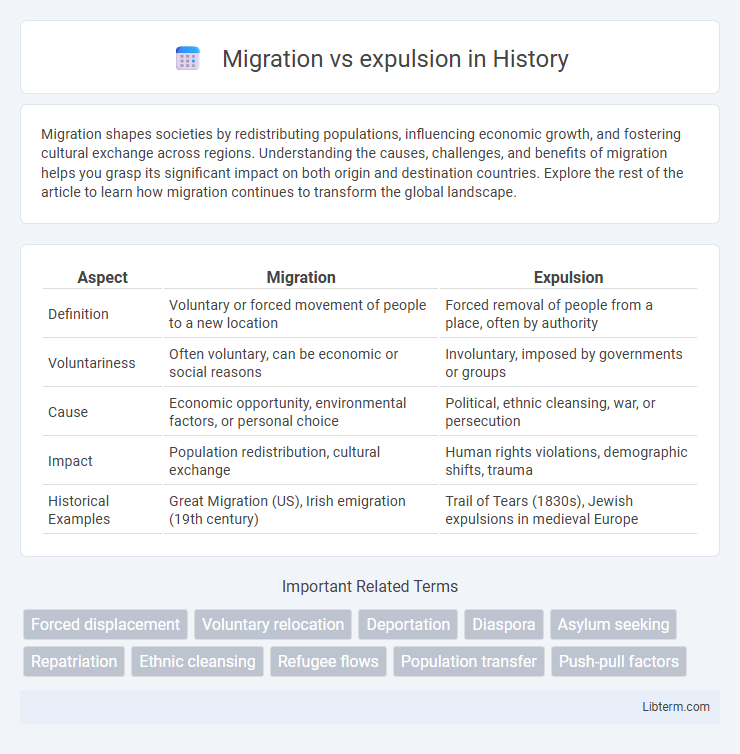Migration shapes societies by redistributing populations, influencing economic growth, and fostering cultural exchange across regions. Understanding the causes, challenges, and benefits of migration helps you grasp its significant impact on both origin and destination countries. Explore the rest of the article to learn how migration continues to transform the global landscape.
Table of Comparison
| Aspect | Migration | Expulsion |
|---|---|---|
| Definition | Voluntary or forced movement of people to a new location | Forced removal of people from a place, often by authority |
| Voluntariness | Often voluntary, can be economic or social reasons | Involuntary, imposed by governments or groups |
| Cause | Economic opportunity, environmental factors, or personal choice | Political, ethnic cleansing, war, or persecution |
| Impact | Population redistribution, cultural exchange | Human rights violations, demographic shifts, trauma |
| Historical Examples | Great Migration (US), Irish emigration (19th century) | Trail of Tears (1830s), Jewish expulsions in medieval Europe |
Understanding Migration and Expulsion: Key Definitions
Migration refers to the voluntary or involuntary movement of people from one place to another, often driven by economic, social, or environmental factors. Expulsion involves the forced removal of individuals or groups from a location, typically by governmental or authoritative power, resulting in displacement under duress. Understanding these key definitions clarifies the distinction between voluntary migration and coercive expulsion, which impact demographics and human rights differently.
Historical Contexts of Migration and Expulsion
Historical contexts of migration often involve voluntary movement driven by economic opportunities, environmental changes, or social factors, as seen in the Great Migration of African Americans in the 20th century. Expulsion typically refers to forced removal authorized by authorities or hostile groups, exemplified by the Armenian Genocide during World War I or the Trail of Tears affecting Native Americans in the 1830s. Understanding these distinctions highlights how migration shapes demographic patterns, while expulsion results in displacement with enduring social and political consequences.
Causes Driving Migration vs. Reasons for Expulsion
Migration is often driven by factors such as economic opportunities, political stability, environmental changes, and social networks that attract individuals seeking better living conditions. Expulsion, in contrast, typically arises from government policies, ethnic conflicts, or security concerns where authorities forcibly remove populations to maintain control or address perceived threats. Understanding these distinct causes highlights migration as a voluntary or semi-voluntary movement, whereas expulsion involves coercion and involuntary displacement.
Legal Perspectives: Rights of Migrants and Expellees
Legal perspectives distinguish migration as a voluntary movement of individuals seeking better opportunities, protected under international human rights law ensuring migrants' rights to work, education, and non-discrimination. Expulsion involves state-enforced removal of individuals, often requiring strict adherence to due process, protection against arbitrary deportation, and compliance with refugee and asylum laws. Both scenarios demand legal frameworks that safeguard human dignity, prevent statelessness, and uphold obligations under treaties such as the 1951 Refugee Convention and International Covenant on Civil and Political Rights (ICCPR).
Social and Psychological Impacts on Individuals
Migration often leads to social integration challenges and identity reconstruction, requiring individuals to adapt to new cultural norms and social networks. Expulsion imposes sudden psychological trauma, including feelings of rejection, loss, and insecurity, severely impacting mental health. Both processes can result in long-term emotional distress, but expulsion typically causes more acute social alienation and psychological instability.
Economic Consequences for Origin and Destination Regions
Migration and expulsion exert distinct economic impacts on origin and destination regions, influencing labor markets, resource allocation, and social services differently. Migration often spurs economic growth in destination areas by filling labor shortages and boosting demand, while remittances sent home enhance development and consumption in origin regions. Conversely, expulsion disrupts these economic flows, leading to loss of human capital in origin countries and potential strain on social cohesion and public services in receiving areas.
Case Studies: Comparing Notable Migrations and Expulsions
Case studies of migration, such as the Syrian refugee crisis, highlight voluntary movement driven by conflict and economic hardship, contrasting sharply with forced expulsions like the 1947 Partition of India, where millions were compelled to relocate amid communal violence. The Great Migration of African Americans in the 20th century illustrates socioeconomic factors prompting relocation within the United States, unlike the ethnic cleansing during the Balkan Wars, which caused coerced expulsions rooted in political and ethnic strife. These comparisons underscore the differing motivations and consequences between migration as a choice and expulsion as a coercive act.
International Responses and Humanitarian Interventions
International responses to migration often emphasize legal frameworks and protection mechanisms under conventions like the 1951 Refugee Convention, ensuring rights and safety for migrants and asylum seekers. Humanitarian interventions focus on providing immediate aid, shelter, and medical care, especially in cases of forced expulsion or mass displacement due to conflict or persecution. Coordinated efforts by organizations such as the UNHCR and IOM aim to balance state sovereignty with human rights, facilitating safe migration pathways and preventing forced expulsions.
Policy Approaches: Managing Migration and Preventing Expulsion
Effective policy approaches to managing migration emphasize regulation through legal pathways, integration programs, and international cooperation to ensure orderly movement and protection of migrants' rights. Preventing expulsion involves establishing clear guidelines for detention, fair asylum procedures, and addressing root causes such as conflict and economic instability to reduce forced displacement. Balancing humanitarian obligations with national security concerns requires adaptive frameworks that promote inclusion while maintaining border integrity.
Future Outlook: Evolving Trends and Global Implications
Future outlook on migration and expulsion reveals increasing complexities driven by climate change, geopolitical tensions, and economic disparities, impacting global population movements. Advanced technologies and international policies are shaping more coordinated responses to migration flows and forced expulsions, emphasizing human rights and sustainable integration. Rising urbanization and demographic shifts in key regions will further influence migration patterns and necessitate collaborative global governance frameworks.
Migration Infographic

 libterm.com
libterm.com